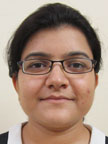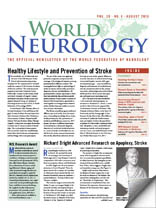I’m deeply grateful to the WFN for awarding me the Junior Traveling Fellowship in 2013 to visit the European Stroke Conference held May 27-31, in London.

Shaily Singh
The conference was attended by more than 3,500 delegates from around the world. Following is the brief outline of the meeting and its structure and discussion items.
The meeting was broadly divided into different themes, with parallel symposia, teaching courses, debates and controversies, oral paper sessions, poster presentations and plenary lectures.
The various themes were acute stroke treatment both interventional and medical, intracerebral hemorrhage, translational neuroscience, arteriopathies, childhood stroke, rehabilitation, small vessel disease, imaging, neuroprotection, outcomes and quality of health services, risk factors, anticoagulation in stroke, and alternative therapies to name a few.
The plenary sessions were on the awards on stroke research and also new trial results announced, including INTERACT 2, SPS3, STITCH 2, imaging results of IST3, etc.
A huge number of research papers and posters were presented during this meeting.
There were parallel halls for oral presentations with different themes to select the area of stroke one is interested in. The timing, discipline and attendance was par excellence.
I had one abstract accepted as first author and was a co-author on one other.
Special e-poster sessions with presentations and question-and-answer sessions were undertaken for the first time for highly rated abstracts. There was a lot of interaction during my e-poster presentation and new ideas generated.
Overall, this meeting was an excellent feast of stroke academics and gave me a great opportunity to present our institutional research, to interact with other stroke researchers from around the world and to collaborate for future research.
Singh is assistant professor of Neurology at the Institute of Human Behavior and Allied Sciences In Delhi, India.
